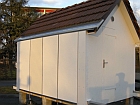|
The paint, varnish and lacquer industry hopes to gain a great deal from nanotechnology. Nanoparticles added to paints, for example, render them corrosion resistant and scratch-proof, and can even make them self-cleaning, explained Joerg Guettinger of the Lake Constance Nano-Cluster. Last year some 4.2 billion US dollars were spent on nano research worldwide, mostly in the EU, USA and Japan. Dietmar Eichenstaedt of the Association of German Varnish and Printing Ink Manufacturers (VdL) used that country as an example to demonstrate the potential at hand. Forty per cent of the 230-odd German varnish and printing ink producers are already using nanotechnology today. This branch of industry manufactures two million tonnes of varnish, paint and printing ink annually, generating a turnover of 5.3 billion Euros. Eichenstaedt predicted that in five years some 15 per cent of the turnover would be derived from “….real nanotechnological applications in «Smart Coatings».”
|


